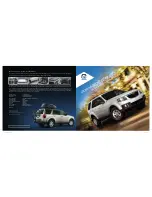
Black plate (26,1)
Chevrolet Camaro Owner Manual - 2010
2-26
Seats and Restraints
Frontal airbags may inflate
at different crash speeds.
For example:
.
If the vehicle hits a stationary
object, the airbags could inflate
at a different crash speed than if
the vehicle hits a moving object.
.
If the vehicle hits an object that
deforms, the airbags could
inflate at a different crash speed
than if the vehicle hits an object
that does not deform.
.
If the vehicle hits a narrow object
(like a pole), the airbags could
inflate at a different crash speed
than if the vehicle hits a wide
object (like a wall).
.
If the vehicle goes into an object
at an angle, the airbags could
inflate at a different crash speed
than if the vehicle goes straight
into the object.
Thresholds can also vary with
specific vehicle design.
Frontal airbags are not intended to
inflate during vehicle rollovers, rear
impacts, or in many side impacts.
In addition, the vehicle has
dual-stage frontal airbags.
Dual-stage airbags adjust the
restraint according to crash severity.
Your vehicle has electronic frontal
sensors, which help the sensing
system distinguish between a
moderate frontal impact and a
more severe frontal impact.
For moderate frontal impacts,
dual-stage airbags inflate at a
level less than full deployment.
For more severe frontal impacts,
full deployment occurs.
Your vehicle has seat-mounted side
impact airbags. Your vehicle may
or may not have roof-rail airbags.
See
Airbag System on page 2
‑
22
.
Seat-mounted side impact and
roof-rail airbags are intended to
inflate in moderate to severe side
crashes. In addition, these roof
‐
rail
airbags are intended to inflate in a
severe frontal impact. Seat-mounted
side impact and roof-rail airbags will
inflate if the crash severity is above
the system's designed threshold
level. The threshold level can vary
with specific vehicle design.
Seat-mounted side impact airbags
are not intended to inflate in frontal
impacts, near-frontal impacts,
rollovers, or rear impacts.
A seat-mounted side impact airbag
is intended to deploy on the side of
the vehicle that is struck. Roof-rail
airbags are intended to deploy on
both sides in some high threshold
frontal impacts.
In any particular crash, no one
can say whether an airbag should
have inflated simply because of
the damage to a vehicle or because
of what the repair costs were.
For frontal airbags, inflation is
determined by what the vehicle hits,
the angle of the impact, and how
quickly the vehicle slows down.
For seat-mounted side impact and
roof-rail airbags, deployment is
determined by the location and
severity of the side impact.
Summary of Contents for 2010 Camaro
Page 6: ...Black plate 6 1 Chevrolet Camaro Owner Manual 2010 vi Introduction 2 NOTES ...
Page 24: ...Black plate 18 1 Chevrolet Camaro Owner Manual 2010 1 18 Keys Doors and Windows 2 NOTES ...
Page 80: ...Black plate 56 1 Chevrolet Camaro Owner Manual 2010 2 56 Seats and Restraints 2 NOTES ...
Page 82: ...Black plate 2 1 Chevrolet Camaro Owner Manual 2010 3 2 Storage 2 NOTES ...
Page 85: ...Black plate 3 1 Chevrolet Camaro Owner Manual 2010 Instruments and Controls 4 3 2 NOTES ...
Page 138: ...Black plate 8 1 Chevrolet Camaro Owner Manual 2010 5 8 Lighting 2 NOTES ...
Page 176: ...Black plate 4 1 Chevrolet Camaro Owner Manual 2010 7 4 Climate Controls 2 NOTES ...
Page 232: ...Black plate 56 1 Chevrolet Camaro Owner Manual 2010 8 56 Driving and Operating 2 NOTES ...
Page 330: ...Black plate 98 1 Chevrolet Camaro Owner Manual 2010 9 98 Vehicle Care 2 NOTES ...
Page 366: ...Black plate 18 1 Chevrolet Camaro Owner Manual 2010 12 18 Customer Information 2 NOTES ...
















































